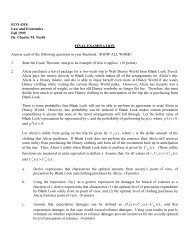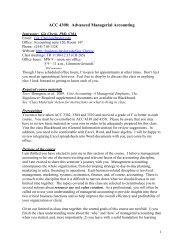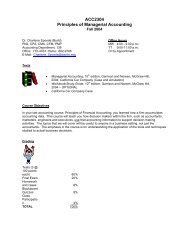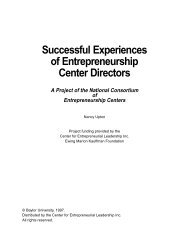1 Chapter 7 Set Sponsorship and Sales Promotion Objectives The ...
1 Chapter 7 Set Sponsorship and Sales Promotion Objectives The ...
1 Chapter 7 Set Sponsorship and Sales Promotion Objectives The ...
Create successful ePaper yourself
Turn your PDF publications into a flip-book with our unique Google optimized e-Paper software.
<strong>Chapter</strong> 7<br />
<strong>Set</strong> <strong>Sponsorship</strong> <strong>and</strong> <strong>Sales</strong> <strong>Promotion</strong> <strong>Objectives</strong><br />
<strong>The</strong> incredible growth of corporate sports sponsorship<br />
spending over the past two decades has generally not been<br />
accompanied with a great deal of marketing planning, either<br />
on the part of the sponsor or the sponsored organization.<br />
<strong>Sponsorship</strong>s have evolved from simply placing signage on<br />
an outfield wall (see Shibe Park/Connie Mack Stadium,<br />
right) to highly leveraged sponsorship arrangements that<br />
may include a full menu of sponsorship activities designed<br />
to activate consumer response (see Table 7.1).<br />
Table 7.1 <strong>Sponsorship</strong> Components<br />
• Signage/venue br<strong>and</strong>ing exposure<br />
• Presenting or Naming rights<br />
• High profile pre event marketing<br />
• ID in promotional materials<br />
• Parties<br />
• Lunches<br />
• Gala Dinners (including athletes)<br />
• Private meeting facilities<br />
• Skyboxes/seats/tickets<br />
• At event surveys<br />
• Pre event research<br />
• Post event research<br />
• Exhibiting<br />
• Trial/Sampling/Product launch<br />
• Client entertainment/hospitality<br />
• Events "within" events<br />
• Program ads<br />
• Broadcast Media ads or mentions<br />
• PA announcements or scoreboard zip ads<br />
• Discounts<br />
• Licensing/Right to use of trademarks/logos<br />
• Mailing lists<br />
• Cross promotions<br />
Since the onset of sponsorship growth in the 1980s, corporate motives <strong>and</strong> objectives for sponsorships have<br />
been unclear. Abratt, Clayton <strong>and</strong> Pitt (1987) reported that the top three reasons for sports sponsorships was for<br />
the potential TV coverage, corporate image promotion, the potential of spectators as customers. While these<br />
may have been (<strong>and</strong> are) important reasons to engage in sports sponsorships, little effort was made to hold<br />
anyone in the organization responsible for determining if <strong>and</strong> how these goals were met (Meenaghan 1983). As<br />
we fast-forward to the new millineum, we find that over 75% of those engaged in sponsorships allocate little or<br />
(mostly) none of their sponsorship budgets to finding out if objectives are being met (see IEG <strong>Sponsorship</strong><br />
Report 2002: Survey Reveals What Matters to Sponsors). Just over 40% rely upon primary consumer research<br />
to determine whether or not to maintain a sponsorship.<br />
Fundamental to any planning process is the need to set clear, measurable objectives to be completed within a<br />
precise timeframe. This implies that:<br />
1. Benchmarks of current performance are measured.<br />
2. <strong>Objectives</strong> are developed. Plans are made to meet objectives.<br />
3. Performance is measured <strong>and</strong> compared to the benchmarks.<br />
Assume that you are a long distance runner. If you set out to improve your time in a marathon race, you must<br />
first know your current performance level. This is your benchmark. You then decide that you want to improve<br />
your time by 10 minutes, or about 23 seconds a mile over the course of the 26.2 mile race. You then develop<br />
1
training plans for the next six months, including plenty of interval training, hillwork,<br />
<strong>and</strong> proper diet to improve your performance. <strong>The</strong>n, at the end of the six<br />
months, you run the marathon you have been training for. As you cross the finish<br />
line you don’t even look at the time as you cross the finish line. No, of course,<br />
you look at the finishing time. That was the whole point—to see how much you<br />
improved! If you don’t know your finishing time to compare it to your last<br />
marathon race, then you won’t know if your training plans were effective. By this<br />
time, however, you don’t care, because you can’t believe you wasted so much<br />
time training for something as stupid as a marathon.<br />
<strong>The</strong> point is that you would think that corporations spending millions <strong>and</strong><br />
millions of dollars on sports sponsorships would be concerned about whether or<br />
not they are achieving their objectives. To be certain, some organizations are.<br />
However, a principle reason that organizations might not seek to determine if<br />
objectives are being met is that they weren’t very clear on the objectives in the<br />
first place.<br />
<strong>The</strong> objectives, then, of this chapter are to introduce possible sports sponsorship objectives, explain how sports<br />
organizations can help sponsors achieve these objectives, pinpoint why sponsorships may fail, <strong>and</strong> to explain<br />
the importance in having a sponsorship policy—just in case Mike Tyson comes to town looking for a fight. In<br />
concluding the chapter, we examine the role of sponsorships in accomplishing sales promotion objectives for<br />
the sponsored organization.<br />
<strong>The</strong> Two sides of <strong>Sponsorship</strong>s: Activation <strong>and</strong> Overservicing:<br />
Jill Born<strong>and</strong> (www.bonham.com) provides a practitioner’s definition of activation:<br />
“Activation refers to putting the sponsorship into action. It could mean many different things, including:<br />
• Leveraging the tie-in advertising or promotions<br />
• Developing that artwork to be used in program ads or signage at the stadium/arena<br />
• Utilizing hospitality offered by the property to entertain guests, customers, etc.”<br />
Sharon Kotler (www.eventivemarketing.com) explains the role <strong>and</strong> interaction of sponsorships <strong>and</strong> advertising:<br />
“<strong>Sponsorship</strong> is often viewed as another form of advertising. When a company elects to ‘sponsor’ an<br />
event or a venue, they pay money for certain rights <strong>and</strong> privileges. Sometimes those rights include<br />
naming the event/venue after that company (known as "naming rights" <strong>and</strong> exemplified by the<br />
Continental Arena or the American Airlines Challenge or the Gatorade Pavilion or the Chevrolet Shoot-<br />
Out, etc). Often those rights include pre-event advertising, <strong>and</strong> at-event signage <strong>and</strong> banners bearing the<br />
company's name or logo (check out the sides of an ice skating rink at a figure skating championship, the<br />
backstop at a baseball game, the brim of Tiger Wood's hat).<br />
But true sponsorship often goes beyond advertising <strong>and</strong> allows the sponsoring company to use the<br />
association with the event or venue for additional promotional means which can include VIP hospitality,<br />
consumer product sampling or even in-store tie-ins. Those privileges or rights require the sponsoring<br />
company to provide the thinking <strong>and</strong> the staffing to fully execute those rights. Hence, sponsorship<br />
activation [can be contracted as] a service provided to companies who do not have the time or the staff<br />
to fully take advantage of those rights <strong>and</strong> privileges without outside resources.”<br />
David Stivers, of Pebble Beach Golf, underlines the importance of activation:<br />
2
“<strong>The</strong> most important terms in sponsorship are: (a) cash, (b) br<strong>and</strong> fit, (c) ability for the sponsor to<br />
enhance our guest experience (e.g. luxury cars, quality golf training equipment, etc...), (d) good fit with<br />
the people (i.e. they underst<strong>and</strong> golf <strong>and</strong> how Pebble Beach works), (e) committed funds to activate the<br />
sponsorship. This last point is key, because the sponsorship will fail if the sponsor does not spend to<br />
support the program.<br />
Critical things we do to attract <strong>and</strong> keep sponsors: (a) our marketing arm acts as an agency for the<br />
sponsor to help them activate, (b) we are creative <strong>and</strong> find new ways to expose our guests to the<br />
sponsors product or services, <strong>and</strong> (c) we are flexible. Every sponsor has a different need <strong>and</strong> different<br />
strategy for connecting with their customers. We provide a venue to help facilitate that connection <strong>and</strong><br />
we have a customer base that is a very attractive target group to our sponsors.”<br />
Scott Brubaker, of the Arizona Diamondbacks, emphasizes that not only should the team or sports entity fit the<br />
sponsor, but that the sponsor should fit within the sports organization’s goals. It is important for the sports<br />
organization to build, <strong>and</strong> not dilute, their own value <strong>and</strong> br<strong>and</strong> equity through sponsorships. If the sports<br />
organization merely takes the sponsors’ money, they are shortchanging the opportunity:<br />
“Obviously the fees we extract are very important to us, but what we truly look for are partners that can help<br />
us move our product forward in the eyes of the marketplace.<br />
• Who is prominent in the community?<br />
• In what other ways do they market, advertise <strong>and</strong> promote their products?<br />
• How will they use our relationship to sell their products?<br />
<strong>The</strong>se are all questions we ask as we sign on new partners. It is a very fluid process.<br />
Service, communication <strong>and</strong> delivery of value are the most critical areas of sponsor retention. Obviously,<br />
the performance of the team defines success to a great degree, but we are able to mitigate lack of success on<br />
the field by over-servicing the needs of our sponsors.”<br />
Over-servicing sponsors means that the sports organization makes every effort to make the sponsorship work<br />
through effective matching, activating, <strong>and</strong> leveraging the sponsorship on the front end <strong>and</strong> communicating,<br />
documenting, <strong>and</strong> following-up on the backend of the deal.<br />
Sports <strong>Sponsorship</strong> <strong>Objectives</strong> <strong>and</strong> Effective <strong>Sponsorship</strong> Planning<br />
Table 7.2 identifies ten generic reasons that companies get involved with sponsorship plans. <strong>The</strong>se ten reasons<br />
represent the means by which the company may seek to achieve its marketing objectives through sponsorships.<br />
Table 7.3 includes a report on the most frequent objectives of sponsorships. <strong>The</strong> #1 objective of sponsorships<br />
today is, not surprisingly, sponsor or br<strong>and</strong> loyalty. Table 7.4 depicts nine reasons that sponsorships fail. <strong>The</strong>se<br />
nine reasons basically stem from an organization’s belief that the sponsorship should work on its own, without<br />
proper management objectives <strong>and</strong> a complete activation plan that leverages the sponsorship. Table 7.5 reminds<br />
organizations to set sponsorship policies so that the organization proactively, not reactively, deals with<br />
sponsorship issues. Table 7.6 is a helpful guide for those considering getting into sponsorships as a marketing<br />
career. Table 7.7 provides an excellent overview of concepts related to sponsorships.<br />
3
Table 7.2<br />
Why Companies Sponsor<br />
From IEG’s Complete Guide to <strong>Sponsorship</strong><br />
Companies do not use sponsorship to replace advertising, public relations or sales promotion campaigns. <strong>The</strong> benefits sponsorship<br />
offers are quite different <strong>and</strong> the medium works best as part of an integrated marketing communications effort that includes the use of<br />
all marketing methods.<br />
<strong>The</strong> following are the most common reasons companies use sponsorship.<br />
1. Heighten visibility<br />
<strong>The</strong> wide exposure events enjoy in both electronic <strong>and</strong> print media provides sponsors with vast publicity opportunities. For many<br />
companies, the cost of purchasing the TV <strong>and</strong> print exposure their sponsorships garner would be unaffordable. For example, for the<br />
cost of a 30-second spot on the Super Bowl telecast, a company can sponsor a team on the NASCAR Winston Cup circuit, which<br />
delivers more than 30 hours of TV coverage.<br />
2. Shape consumer attitudes<br />
Br<strong>and</strong>s with huge ad budgets <strong>and</strong> high unaided recall do not need sponsorship to generate visibility. Instead, they often sponsor for<br />
the lifestyle association the sponsored property represents. <strong>The</strong>y are looking to the event to have a rub-off effect on their image <strong>and</strong><br />
ultimately their sales.<br />
“Coca-Cola is the world’s most recognizable trademark,” said the director of sports marketing, Coca-Cola USA. “However, if you did a<br />
survey on the streets of Chicago <strong>and</strong> asked people what was more important to them, Coca-Cola or the Chicago Bulls, nine out of 10<br />
would probably say the Bulls. We accept that <strong>and</strong> try to borrow that equity by becoming their sponsor.”<br />
Miller Lite’s sponsorship of pro beach volleyball is another example of an image-driven tie. By becoming synonymous with beach<br />
volleyball, the br<strong>and</strong> is identified with a lifestyle emulated by its young adult target market. “Consumer attitudes are the hardest thing<br />
to change,” said a Miller marketing executive. “And the more our br<strong>and</strong> is part of events that are part of a consumer’s lifestyle, the<br />
more we can affect his or her attitude toward the product.”<br />
3. Communicate commitment to a particular lifestyle<br />
<strong>The</strong> era of the mass audience is gone. Instead, companies are narrowcasting, tailoring specific messages to small, targeted<br />
segments. <strong>Sponsorship</strong> is an effective vehicle for this type of individualized communication. Opportunities are divisible by age,<br />
income, geography <strong>and</strong> gender. <strong>The</strong>y segment markets along geographic, ethnic, psychographic <strong>and</strong> demographic lines. <strong>Sponsorship</strong><br />
allows companies to hone in on a niche market without any waste.<br />
4. Business-to-business marketing: incenting the trade<br />
Competition for shelf space is one of the biggest issues facing companies today <strong>and</strong> many are using sponsorship to win the battle.<br />
For example, many of the companies sponsoring stock car racing do so to offer retailers perks such as driver appearances at stores<br />
<strong>and</strong> event tickets in exchange for incremental case orders <strong>and</strong> in-store product displays. <strong>Sponsorship</strong> of all types can be used to<br />
incent wholesalers, retailers, dealers <strong>and</strong> other intermediaries in the distribution channel.<br />
5. Differentiate product from competitors<br />
This objective is what is driving much of the sponsorship by service industries like banking, insurance <strong>and</strong> telecommunications.<br />
<strong>Sponsorship</strong> provides companies a competitive selling advantage because it offers opportunities for category exclusivity <strong>and</strong> can be<br />
used as a platform for creating currency with customers. Sponsors take the rights associated with their properties <strong>and</strong> make them<br />
work for the customer to help achieve their needs <strong>and</strong> objectives, for example, a discount on tickets or a pit pass to a NASCAR race.<br />
It is a value-added promotion that the competition can not duplicate.<br />
6. Entertain clients<br />
Many companies sponsor for hospitality opportunities. For example, golf tournament sponsors offer their key clients pro-am spots,<br />
giving sponsors the opportunity to spend a few hours with important customers <strong>and</strong> solidify business relationships. Events make great<br />
settings for this informal networking. <strong>The</strong>y are unique <strong>and</strong> desirable, two things that are absolutely necessary to entice a business<br />
contact to join you during non-business hours.<br />
7. Merch<strong>and</strong>ising opportunities<br />
As consumer buying decisions are increasingly being made in-store (80 percent of all product choices are now made at the retail<br />
level), marketers need to have relevant promotions for consumers at the point of purchase. A sports or entertainment tie can bring<br />
excitement, color <strong>and</strong> uniqueness to a p-o-p display <strong>and</strong> can be merch<strong>and</strong>ised weeks or months in advance. <strong>The</strong> opportunity to have<br />
items available as giveaways or for sale is valuable because this type of merch<strong>and</strong>ise is immensely popular with consumers <strong>and</strong> can<br />
be used to provide a key point of difference when offered in conjunction with an<br />
in-store promotion.<br />
8. Showcase product attributes<br />
<strong>Sponsorship</strong> allows companies to call attention to product benefits. For example, tire manufacturers sponsor auto racing to<br />
demonstrate their product in action.<br />
9. Combat larger ad budgets of competitors<br />
<strong>The</strong> cost-effectiveness of sponsorship relative to traditional media advertising allows smaller companies to compete with the giants of<br />
their industry. Mercury Communications could not match rival British Telecom’s mighty media budget <strong>and</strong> used sponsorship of the<br />
U.K.’s Prince’s Trust charity <strong>and</strong> a Royal Academy of Arts exhibit to build awareness, increase sales <strong>and</strong> strip market share from its<br />
only competitor. Mercury tied its phone cards to both sponsorships. <strong>The</strong> company donated a portion of each Mercury Prince’s Trust<br />
affinity card sale to the charity; it also commissioned artists to design Pop Art cards that coincided with the Royal Academy exhibit.<br />
4
Table 7.3<br />
IEG/Performance Research Survey Reveals What Matters To Sponsors<br />
03/11/02 From IEG <strong>Sponsorship</strong> Report<br />
At Issue: What criteria are sponsors using to evaluate new <strong>and</strong> existing deals? How<br />
much are they allocating to sponsorship <strong>and</strong> its activation <strong>and</strong> measurement?<br />
Takeaway: Exclusivity remains top benefit; increasing br<strong>and</strong> loyalty is still chief<br />
objective; some increase in leveraging <strong>and</strong> research.<br />
<strong>The</strong> second annual IEG/Performance Research <strong>Sponsorship</strong> Decision-makers<br />
Survey shows an increase in sponsors’ allocating resources to activation <strong>and</strong><br />
research. Overall, the survey of 200-plus corporate marketers reinforces many of the<br />
findings from the previous year.<br />
How will your 2002 sponsorship spending compare to<br />
While the current survey provides plenty of evidence that a large number of sponsors 2001?<br />
still devote precious little to the key areas of evaluation <strong>and</strong> leveraging, a few indicators point to progress. For example, the average<br />
ratio of activation spending to rights fees doubled to 2.4-to-1.<br />
That increase, however, is in large part the result of greater spending by sponsors who already believe in activation. <strong>The</strong> percentage of<br />
respondents spending 2-to-1 or more rose from 29 percent to 33 percent, including a jump from three percent to eight percent in those<br />
spending 4-to-1 or more. Roughly two-thirds of respondents allocated $1 or less for activation per each rights fee dollar.<br />
<strong>The</strong> survey, which IEG commissioned <strong>and</strong> Performance Research conducted last month, yielded similar positive results with mitigating<br />
factors in the research area. <strong>The</strong> number of respondents with a dedicated budget for ongoing sponsorship research grew from 22<br />
percent to 32 percent. However, the size of those budgets is often extremely small, as the percentage of respondents who allocated<br />
nothing or no more than one percent of their total sponsorship spending to research remained high at 76 percent.<br />
Spending to research the appropriateness of sponsorship opportunities ticked upwards, as 29 percent of respondents indicated they<br />
spend more than $5,000 on pre-decision analysis, as opposed to 23 percent last year.<br />
Sponsors indicated the same commitment to sponsorship as in 2001: 12 percent of their marketing budgets. Nearly half said they were<br />
maintaining spending for ’02 at ’01 levels, while 29 percent were increasing, <strong>and</strong> 25 percent were decreasing.<br />
What Can Properties Provide?<br />
Sponsors are lessening their reliance on properties to help measure return on investment. On a scale in which 10 is “completely<br />
dependent on properties,” companies rated themselves a 4.6, down from 5.1 last year. This may be the result of growing frustration<br />
with the information <strong>and</strong> services properties deliver: Sixty-eight percent of respondents said properties do not meet their expectations<br />
in this area, up from 61 percent last year.<br />
Marketers showed a much higher level of interest in research on sponsor loyalty, which replaced research on sponsor recall as the<br />
second most valuable property-provided service–an indication that they may be growing more sophisticated in their measurement<br />
approach. Post-event reports <strong>and</strong> fulfillment audits remained the number one service.<br />
Exclusivity Still Considered Most Important Benefit<br />
Despite willingness by some companies in multi-faceted industries such as telecommunications <strong>and</strong> financial services to split their<br />
categories, most sponsors continue to deem exclusivity sponsorship’s most important benefit. Sixty-two percent rated it a 9 or 10. Onsite<br />
signage remained the second most valuable benefit (46 percent), followed by broadcast ad opportunities (42 percent), which<br />
surpassed ID in a property’s media buy (37 percent) <strong>and</strong> title of a proprietary area (36 percent).<br />
Top Objective: Increase Br<strong>and</strong> Loyalty<br />
Sponsors’ ability to borrow affinity from properties to grow consumer loyalty remains the key goal for most respondents, with 62 percent<br />
rating it a 9 or 10. It was followed closely by generating awareness/visibility (60 percent) <strong>and</strong> changing/reinforcing image (56 percent).<br />
<strong>The</strong> one objective to grow significantly in importance was on-site sales rights. While still less valued than eight other objectives, on-site<br />
sales received a 9 or 10 from 21 percent of respondents, compared with 13 percent in ’01. Two other objectives suffered the opposite<br />
fate: Showcasing community/social responsibility slid from a 9 or 10 rating by 43 percent of respondents in ’01 to 32 percent, while<br />
entertaining clients/prospects declined from 31 percent to 22 percent.<br />
<strong>The</strong> downward shift in the importance of demonstrating social responsibility–surprising in the wake of September 11–is most likely the<br />
result of a greater number of non-U.S. respondents to this year’s survey <strong>and</strong> an increase in the valuation of bottom-line-oriented<br />
results, spurred by the economy. Indeed, the only objectives that saw any increase in the number of respondents ranking them a 9 or<br />
5
10 were stimulating sales/trial/usage, sampling/displaying/showcasing products/services <strong>and</strong> on-site sales.<br />
Despite the emphasis on br<strong>and</strong> loyalty <strong>and</strong> image reinforcement or enhancement, sponsors’ post-event analysis still is surprisingly<br />
lacking in direct consumer research. Only 41 percent of respondents mentioned primary consumer research as a method they use to<br />
decide whether to renew a sponsorship, down from 47 percent in ’01<br />
Selection Criteria<br />
Demographics <strong>and</strong> attendance held firm as the two most-often used criteria to determine what to sponsor. However, while 89 percent<br />
of respondents cited demographics, the number of those indicating attendance dropped significantly, to 71 percent versus 82 percent<br />
last year. Fan passion/affinity took third place, noted by 60 percent of those surveyed.<br />
Respondents’ companies sponsor sports (58 percent), community events (31 percent), causes (27 percent), arts (20 percent) <strong>and</strong><br />
entertainment (seven percent).<br />
©2002 IEG, Inc. All Rights Reserved. For more information about IEG's products <strong>and</strong> services, please visit<br />
www.sponsorship.com or call 312/944-1727.<br />
Table 7.4 Why <strong>Sponsorship</strong>s Fail<br />
From IEG’s Complete Guide to <strong>Sponsorship</strong><br />
Up until the late 1980s, the CEO Syndrome -- when a company sponsors yacht racing because a top executive likes yachting -- was<br />
the primary cause of ineffective sponsorships.<br />
While sponsorship decision-making is still not totally immune to this kind of subjectivity, growing accountability to stockholders <strong>and</strong><br />
stakeholders has resulted in a more professional approach to sponsorship.<br />
Today, far more complex reasons are usually behind sponsorship programs that run amok. <strong>The</strong> most common ones are detailed<br />
below:<br />
Greenwashing. Don’t sponsor green unless you are green. <strong>Sponsorship</strong>s are coming under increasing scrutiny <strong>and</strong> those perceived<br />
as PR ploys will backfire. Whether it is an environmental tie or a tie to sports, unless a sponsor is genuinely seen to be enabling a<br />
recipient organization, the strength of feeling that is engendered can very easily turn against the company, as it will be seen merely as<br />
exploiting a situation.<br />
Signing the check <strong>and</strong> dropping the ball. <strong>Sponsorship</strong> is rarely an efficient buy for companies expecting the pay-off to come through<br />
on-site visibility; on a cost-per-thous<strong>and</strong> basis, the return is not there. <strong>Sponsorship</strong>s must be commercialized weeks or months in<br />
advance <strong>and</strong> leveraged with an audience far broader than at the venue. Sponsors should budget anywhere from 10 cents to 10 dollars<br />
for every dollar spent on rights fees, depending on the type of property being sponsored. For example, if the title sponsor of a college<br />
bowl game wants its name kept in the title on the TV broadcast, it must buy about 25 percent of the ad time. This is on top of the fee<br />
paid to be the event’s title sponsor. On the other h<strong>and</strong>, a sponsor of a race car team gets ID in front of the audiences at every event in<br />
which the team competes, even if they are not an event sponsor, as well as on TV, even if they don’t buy any ad time.<br />
Due diligence overlooked. Knowing what you are not getting is often as important as knowing what you are getting. For example,<br />
does the sanctioning body you are about to sign with control marketing rights to the events it sanctions? How about the athletes that<br />
compete in them? Does league sponsorship include marketing rights to teams? Who controls advertising on broadcasts? Does official<br />
water status cover both sparkling <strong>and</strong> flat waters? What are the legalities <strong>and</strong> liabilities associated with the property?<br />
Property hopping. One-year commitments are generally of dubious benefit. Creating a link between a sponsor <strong>and</strong> a property is<br />
rarely accomplished overnight. Also, the learning curve in sponsorship is longer than other media, <strong>and</strong> sponsors usually do not know<br />
how to fully maximize an involvement with a particular property in the first year.<br />
Too many little sponsorships. It is generally much more effective to build equity by concentrating sponsorship funds than by<br />
spreading them around. This can take the form of multiple lower- <strong>and</strong> middle-level packages within a single property type or buying<br />
top-level packages at one or two properties.<br />
Insufficient staffing. Even turnkey packages require additional staff time for everything from hosting clients on site to approving<br />
artwork with sponsor ID.<br />
Competition for trade participation by cosponsors. When companies whose products are sold through the same distribution<br />
channel sponsor the same property, impact is often diluted. Sponsors find themselves competing with each other for retail participation<br />
<strong>and</strong> under-mining the value of each other’s offers in the consumer’s mind. Both sponsors <strong>and</strong> properties need to consider not only<br />
exclusivity within a product category but also the number of cosponsors with the same sales outlets.<br />
6
Failure to sell internally. <strong>Sponsorship</strong>, unlike traditional media, will not reach consumers unless the field gets behind it <strong>and</strong> sells it to<br />
the trade, who then must promote it. A program will not work unless the concept is sold throughout the system <strong>and</strong> meets the needs of<br />
all the various constituencies.<br />
Overlooking the fans. <strong>Sponsorship</strong> will not work if it is imposed on an audience. Sponsors <strong>and</strong> properties must help audiences look<br />
beyond the obvious trappings of sponsorship, such as perimeter signage, to the value-added benefits sponsors are bringing. It must be<br />
communicated to fans <strong>and</strong> audiences that, as a result of the sponsorship, they are getting events that would not otherwise visit their<br />
market, more affordable ticket prices, enhanced programming or some other tangible benefit. To make an impact, it is key that the<br />
sponsor is seen as bringing something to the event. <strong>The</strong> activity must be perceived as being provided by the br<strong>and</strong> rather than simply<br />
sponsored by it.<br />
©2002 IEG, Inc. All Rights Reserved. For more information about IEG's products <strong>and</strong> services, please visit<br />
www.sponsorship.com or call 312/944-1727.<br />
Table 7.5 What’s Your <strong>Sponsorship</strong> Policy?<br />
Lesa Ukman, President & Founder, IEG, Inc.<br />
Sometimes, the biggest obstacles to selling sponsorship are internal staff or members of the board of directors who oppose<br />
sponsorship or operate under dated ideas that do not reflect the marketplace.<br />
While a sponsorship policy will not solve every problem, all rightsholders--for profit <strong>and</strong> nonprofit--should have written sponsorship<br />
guidelines, governing what is <strong>and</strong> is not for sale; which industries are <strong>and</strong> are not acceptable; <strong>and</strong> how to balance the needs of<br />
sponsors <strong>and</strong> the organizations’ need to maintain athletic/intellectual/artistic integrity.<br />
<strong>The</strong> creation <strong>and</strong> annual review of policy institutionalizes ongoing examination of the issues. <strong>The</strong> policy, or at the least its governing<br />
philosophy, should be shared with all stakeholders: fans, members, sponsors, media, etc.<br />
No set of rules can fit every circumstance, <strong>and</strong> except for violations of nonprofit law, the guidelines are just that, guides not absolutes.<br />
And what works for one, will not necessarily work for another. For example, while an environmental organization is likely to welcome a<br />
partnership with an environmentally responsible marketer of c<strong>and</strong>y bars, a school district may want to partner only with healthful foods.<br />
Your sponsorship policy should address:<br />
<strong>Sponsorship</strong> objectives: Is the primary motive for selling sponsorship cash or would promotional commitments–-which can<br />
drive attendance, membership, donations, awareness, etc.–-be more valuable?<br />
What rights will <strong>and</strong> will not be incorporated into your sponsorship offers?<br />
Will you allow category exclusivity?<br />
How about title?<br />
Who determines what can <strong>and</strong> can’t be sponsored?<br />
Are there companies or business categories from which you will not accept sponsorship?<br />
Who are they <strong>and</strong> what’s the rationale?<br />
Who’s in charge of selling? Who can sign the contract? Who manages servicing?<br />
When <strong>and</strong> how often will the policy be reviewed?<br />
Table 7.6 Is <strong>Sponsorship</strong> a Smart Career Move?<br />
From IEG <strong>Sponsorship</strong> Report<br />
AT ISSUE: Is experience as a sponsorship manager a good stepping stone?<br />
TAKEAWAY: Those responsible for integrated sponsorships develop multiple skills, but must market themselves properly to avoid<br />
being categorized as specialists.<br />
7
John Hancock Financial Services, Inc. CEO David D’Aless<strong>and</strong>ro represents many things to many people. To Olympic officials, he is<br />
both benefactor <strong>and</strong> prosecutor. To Hancock shareholders, he is–for now at least–a genius. To network TV execs, he is a scourge.<br />
And to those who have chosen to devote a significant part of their careers to buying <strong>and</strong> managing sponsorships, he is a patron saint.<br />
D’Aless<strong>and</strong>ro is the one shining example of someone who has made his mark as a sponsor <strong>and</strong> rose all the way to the top of the org<br />
chart.<br />
But for every sponsorship manager who sees D’Aless<strong>and</strong>ro’s rise as a beacon of hope, there are others who say he is the exception<br />
that proves the rule: Choosing sponsorship as a career path does not place one in the express lane to the executive suite.<br />
Whether to concentrate on sponsorship is a dilemma unique to buyers. <strong>Sponsorship</strong> salespeople, if they demonstrate themselves<br />
adept, will not lack opportunity within the industry. And should they choose to sell in another field, an established track record as a<br />
deal-closer will be welcomed almost anywhere.<br />
As for buyers seeking to move up the corporate ladder–or at least transition to other areas within their own companies or elsewhere–<br />
they must ask whether sponsorship is the road to success or a dead end.<br />
<strong>The</strong> Trouble with <strong>Sponsorship</strong><br />
For all of the gains sponsorship has made in becoming an integral part of marketing, many in the industry still run into internal <strong>and</strong><br />
external executives with an old-fashioned <strong>and</strong> limiting view of the discipline.<br />
“Despite the fact that sponsorship is a more significant tool than ever <strong>and</strong> should be considered a mainstream activity, it is not,” said<br />
Derek Murphy, who left his position as vice president, sponsorship marketing at American Express Co. last year <strong>and</strong> is now vice<br />
president, business development & marketing communications for Skillgames, Inc., Walker Digital’s online gaming venture with Walt<br />
Disney Co.<br />
“<strong>Sponsorship</strong> was definitely below the radar screen at Amex in terms of being understood. It is very rare that when I say sponsorship,<br />
people really know what that means. <strong>The</strong>re is still a knee-jerk response that it’s about putting up signs.”<br />
<strong>The</strong> job-hunting experience of even veteran sponsorship executives does not paint a pleasant picture. For example, Mava Heffler,<br />
former senior vice president, global promotions <strong>and</strong> sponsorships for MasterCard Int’l, Inc., faced an uphill struggle when she left the<br />
company two years ago.<br />
“It was bad enough I was leaving MasterCard in part because sponsorship didn’t get the credit <strong>and</strong> respect it deserved,” she said.<br />
“<strong>The</strong>n to be faced with marketing executives <strong>and</strong> hiring people who viewed sponsorship so myopically <strong>and</strong> to be br<strong>and</strong>ed as a limited<br />
person was very upsetting.”<br />
Even with a Harvard Business School case study documenting the integrated marketing programs <strong>and</strong> ROI of MasterCard’s FIFA<br />
World Cup sponsorship, Heffler found it difficult to shake others’ perception that sponsorship is a separate, specialized discipline.<br />
Having recently left her most recent position as senior vice president, marketing <strong>and</strong> research at CNBC, Heffler now is having an<br />
easier time presenting her credentials. “My abilities are no different, but they have been legitimized by my latest job functions.”<br />
Sprint Corp.’s Mike Goff parlayed success as chief architect of the company’s sponsorship portfolio into a position as vice president of<br />
br<strong>and</strong> management, where his responsibilities include the telco’s online presence <strong>and</strong> media buying. However, he has no illusions that<br />
Sprint’s well-respected sponsorship campaigns would have been enough to propel him farther up the hierarchy. “I wouldn’t have been<br />
given this responsibility if I didn’t have experience in traditional marketing management <strong>and</strong> in an ad agency,” he said. “If your sole<br />
focus is sponsorship, you will be seen as a specialist, <strong>and</strong> that will limit your potential to advance.”<br />
Part of the problem is that at most companies, advancement beyond middle management means leaving sponsorship behind. While<br />
Heffler experienced some frustration once she got there, at least she was one of the few who have been able to attain a senior<br />
executive-level sponsorship position.<br />
Rarely does the top sponsorship position rank higher than the director level. Even with estimated budgets in excess of $65 million, four<br />
of IEG SR’s top 10 U.S. sponsors (IEG SR, Dec. 18, 2000) do not confer vice president status on their highest-ranking sponsorship<br />
executive.<br />
“With the exception of a Coca-Cola or Nike, there aren’t a whole bunch of sponsorship jobs at a senior level; in that way it is a very<br />
limiting career,” said Art McCabe, vice president of global marketing for the ADC Software Systems Division of ADC<br />
Telecommunications, Inc. <strong>and</strong> former director, corporate event marketing for Ericsson Mobile Communications AB.<br />
Fighting Perceptions with Reality<br />
For those looking to transition into new areas, it is possible to overcome the objections of people with an outdated or simply incorrect<br />
view of sponsorship. <strong>The</strong>y must be shown that a background in sponsorship means experience in just about every other marketing<br />
discipline.<br />
That task should be relatively straightforward if the c<strong>and</strong>idate has experience with fully integrated sponsorship programs. “Working on<br />
a well managed sponsorship campaign is like getting a mini MBA,” said Cathy Griffin, managing director, sports <strong>and</strong> entertainment for<br />
8
executive recruiter Korn/Ferry Int’l, who began her career in the sports marketing department at Pepsi-Cola USA in the mid 1980s.<br />
In addition to delivering experience in media advertising, promotions, direct marketing, PR, loyalty programs, B2B marketing <strong>and</strong> enduser<br />
sales, integrated sponsorships offer managers the potential to acquire skills in negotiating, valuing, project management, internal<br />
sales, joint ventures <strong>and</strong> crisis management.<br />
“Even if the person reviewing your resume does not underst<strong>and</strong> sponsorship, they will underst<strong>and</strong> the skills that go into it,” said<br />
Pamela Robinson, owner of an eponymous executive recruiting firm specializing in entertainment marketing.<br />
She points out that sponsorship managers putting together their credentials should follow the same advice they give to sponsorship<br />
sellers looking to send proposals: “Don’t just spell out your attributes, do research on what issues the company is facing <strong>and</strong> show<br />
them how you can help meet their objectives.”<br />
Among the most marketable skills gained by sponsorship managers are those stemming from evaluating opportunities, crafting<br />
deals <strong>and</strong> measuring return. “You learn how to assess a potential partner’s assets, as well as self-assess the assets you bring,”<br />
Murphy said, noting that such experience is good preparation for working on a variety of partnerships–from hiring CRM vendors to<br />
negotiating content agreements.<br />
“Doing due diligence means underst<strong>and</strong>ing the business models of a number of different properties, while working with various ROI<br />
models is something that people in other marketing areas rarely develop an acumen for,” said McCabe.<br />
Even managers who work for a company where sponsorships are not completely activated can take steps to put their best foot<br />
forward. “Build relationships with colleagues in traditional marketing departments or in one of the key business units,” Goff advised.<br />
“Learn from them <strong>and</strong> leverage those contacts.”<br />
“If sponsorship is seen as an isl<strong>and</strong>, the onus is on you to build bridges <strong>and</strong> position yourself <strong>and</strong> your department as creating new<br />
business opportunities <strong>and</strong> embracing innovation <strong>and</strong> creativity,” said Murphy.<br />
<strong>The</strong> good news is the situation can only improve. Inevitably, as marketers <strong>and</strong> executives who have only known sponsorship as a<br />
completely integrated marketing vehicle move into positions of authority, job applicants with sponsorship experience will no longer<br />
need to make the case for the medium.<br />
Patrick Cotting, who last week left his post as vice president, marketing alliances <strong>and</strong> sponsorships at Credit Suisse E-Investment<br />
Services Europe to join broadcaster Eurosport as director strategic alliances, believes sponsorship will slowly but surely gain respect,<br />
just as marketing in general has. “Fifteen years ago, marketing was seen as a soft subject, not that important to the overall health of a<br />
business. Now, financial <strong>and</strong> investment analysts’ reports point to marketing <strong>and</strong> br<strong>and</strong>ing as among the most important assets of a<br />
company.”<br />
Positioning for Advancement<br />
Below, some steps those looking to move on <strong>and</strong> up can take:<br />
1. Avoid sponsorship departments that are not part of the central br<strong>and</strong> development or marketing function. “<strong>Sponsorship</strong><br />
managed out of the office of the president or considered a staff position rather than a line management position makes it much easier<br />
for a recruiter or hiring contact to dismiss it as strictly executional,” said Buffy Filippell, president of sports executive search firm<br />
TeamWork Consulting, Inc., herself a former Wilson Sporting Goods sports marketer <strong>and</strong> IMG staffer.<br />
2. Exploit revenue-generating opportunities. Even if their current position does not require a payout analysis of projects,<br />
sponsorship managers should quantify the impact their efforts have on the bottom line. “Revenue generators advance the quickest at<br />
most companies,” said Tom Mueller, president of Sport Management, Inc. Mueller was responsible for ties at Mercury Marine in the<br />
early 1990s. “When I was a sponsorship manager, we often got wrapped up in how big a budget we had control of. People who are<br />
going to hire you don’t care how much you can spend, they want to know what you can bring in.”<br />
3. Lobby for a change in terminology. Since many employers have preconceived notions of sponsorship, those with that term in<br />
their departments <strong>and</strong> titles should seek a new descriptor. Marketing alliances, business partnerships or partnership marketing are<br />
possibilities. “Marketing alliances implies more than the supporting instrument role played by sponsorship. It suggests partnerships<br />
closer to joint ventures,” Cotting said.<br />
4. Use resumes for clarification. “<strong>The</strong> biggest mistake people make is to assume that the people looking at a resume are familiar<br />
with what the previous employer does, what the duties of a position are <strong>and</strong> where it fits in the organization,” Filippell said. “Titles can<br />
be misleading, so everything must be spelled out.”<br />
5. Don’t wait too long to make a change. For those considering taking their sponsorship skills to the property or agency side or<br />
seeking a different management position at another corporation, a move is easier before they advance too far. “<strong>The</strong>re is an element of<br />
risk in hiring someone who is changing roles,” Filippell pointed out. “At a salary level of $50,000 to $100,000, an organization will take<br />
that risk, but a senior vice president making $200,000 may be too big a leap.”<br />
<strong>Sponsorship</strong> Stops Along the Way<br />
9
Paula Balzer, Chief marketing officer, Clear Channel Entertainment<br />
1990: Vice president, client service, Contemporary Group<br />
1988: Manager, special events, Maxwell House Coffee Co.<br />
1986: Vice president, Lobsenz-Stevens<br />
Jeff Bliss, President, <strong>The</strong> Javelin Group<br />
1994: President & CEO, Sara Lee Olympic Partnership<br />
1989: Senior vice president & chief marketing officer, World Cup USA 1994<br />
1984: Director, corporate sponsors, Los Angeles Olympic Organizing Committee<br />
Ron Dickson, Partner, Three Wide<br />
1999: Vice president, corporate partnerships, Eastman Kodak Co.<br />
1995: General manager, marketing communications, Eastman Kodak Co.<br />
1994: President, direct division, Barkley & Evergreen Advertising<br />
Mava Heffler, Senior vice president, marketing <strong>and</strong> research, CNBC (through August 3, 2001)<br />
1999: Senior vice president, Cendant Netmarket Group, Inc.<br />
1995: Senior vice president, global promotions & sponsorships, MasterCard Int’l, Inc.<br />
1985: Director, sales promotion & PR/Personal Products Co., Johnson & Johnson<br />
Steve Koonin, Executive vice president <strong>and</strong> general manager, Turner Network Television<br />
1998: Vice president, consumer marketing, <strong>The</strong> Coca-Cola Co.<br />
1989: Director, entertainment marketing, Coca-Cola USA<br />
1986: <strong>Promotion</strong>s manager, fountain sales, Coca-Cola USA<br />
<strong>Set</strong>h Matlins, Corporate consulting, Creative Artists Agency<br />
1998: President, Rock <strong>The</strong> Vote<br />
1994: Vice president, ProServ<br />
1989: Special events coordinator, Evian Waters of France, Inc.<br />
Tom Mueller, President, Sport Management, Inc.<br />
1995: Executive director of pro competition, American Motorcyclist Assn.<br />
1989: Marketing director, Mercury Marine<br />
1987: Manager, PR <strong>and</strong> promotions, Wrangler Jeans<br />
Derek Murphy, Vice president, business development & marketing communications, Skillgames, Inc.<br />
1999: Vice president, sponsorship marketing, American Express Co.<br />
1992: Manager, corporate strategic planning, American Express Co.<br />
1991: Associate, corporate finance, Bankers Trust<br />
Drew Sheinman, President, Simon Br<strong>and</strong> Ventures<br />
1992: Director of sports management, Coca-Cola USA<br />
1990: Vice president, business development, Madison Square Garden Enterprises<br />
1986: Vice president, marketing, MLB New York Mets<br />
Cindy Sisson, Partner, Tailwind Sports, LLC<br />
1995: Director of marketing, Roush Marketing Services, Inc.<br />
1993: Manager of sports marketing, Gatorade<br />
1991: Director of promotions, LPGA<br />
Tony Wells, Vice president, regional managing director, General Motors R*Works Western region<br />
2000: Senior director, national sales, SFX Sports Group<br />
1997: Vice president, partnership marketing & sales, <strong>The</strong> Mills Corp.<br />
1995: Advertising manager, Mid-Atlantic region, Nissan Motor Corp. U.S.A.<br />
Table 7.7 IEG <strong>Sponsorship</strong> Glossary <strong>and</strong> Lexicon<br />
Jim Andrews, Vice President, IEG, Inc.<br />
Activation: <strong>The</strong> marketing activities a company conducts to promote its sponsorship. Money spent on activation is over <strong>and</strong> above the<br />
rights fee paid to the sponsored property. Also known as leverage.<br />
10
Ambush Marketing: A promotional strategy whereby a non-sponsor attempts to capitalize on the popularity/prestige of a property by<br />
giving the false impression that it is a sponsor. Often employed by the competitors of a property’s official sponsors.<br />
Arts Marketing: <strong>Promotion</strong>al strategy linking a company to the visual or performing arts (sponsorship of a symphony concert series,<br />
museum exhibit, etc.). See: <strong>Sponsorship</strong><br />
Audio Mention: <strong>The</strong> mention of a sponsor during a TV or radio broadcast.<br />
Business-to-Business <strong>Sponsorship</strong>: Programs intended to influence corporate purchase/awareness, as opposed to individual<br />
consumers.<br />
Category Exclusivity: <strong>The</strong> right of a sponsor to be the only company within its product or service category associated with the<br />
sponsored property.<br />
Cause Marketing: <strong>Promotion</strong>al strategy that links a company’s sales campaign directly to a nonprofit organization. Generally includes<br />
an offer by the sponsor to make a donation to the cause with purchase of its product or service. Unlike philanthropy, money spent on<br />
cause marketing is a business expense, not a donation, <strong>and</strong> is expected to show a return on investment. See: <strong>Sponsorship</strong><br />
Core Sponsor: Concept developed by IEG to describe companies whose sponsorships are aligned with internal practices. Rather<br />
than using sponsorship as a marketing ploy, Core Sponsors gain loyal customers by living their values. What they sponsor reflects the<br />
DNA of their br<strong>and</strong>. Core Sponsors include Ben & Jerry’s, Harley-Davidson, Patagonia, Timberl<strong>and</strong>, Vans, Virgin <strong>and</strong> Yoplait.<br />
Core Sports: Term developed by Vans to refer to youth sports that feature individual, rather than team, competition, including:<br />
skateboarding, snowboarding, surfing, wakeboarding, BMX, supercross, <strong>and</strong> freestyle motocross.<br />
Cosponsors: Sponsors of the same property.<br />
Cost/Benefit Ratio: This is the ratio that IEG has developed based on market pricing to determine the amount of value a sponsor<br />
expects for each dollar invested in rights fees.<br />
CPM (Cost Per Thous<strong>and</strong>): <strong>The</strong> cost to deliver an ad message to a thous<strong>and</strong> people.<br />
Cross-<strong>Promotion</strong>s: A joint marketing effort conducted by two or more cosponsors using the sponsored property as the central theme.<br />
Customer Loyalty: <strong>The</strong> new imperative of marketing. As the marketplace approaches a supersaturation of products - as the power in<br />
the marketing equation shifts from product to consumer - br<strong>and</strong> loyalty disappears. To survive, companies will have to create loyalty<br />
relationships with their customers, one customer at a time.<br />
Editorial Coverage: Exposure that is generated by media coverage of the sponsored property that includes mention of the sponsor.<br />
Emblem: A graphic symbol unique to a property. See: Mark<br />
Escalator: An annual percentage increase built into the sponsorship fee for multi year contracts. Escalators are typically tied to<br />
inflation.<br />
Event Marketing: <strong>Promotion</strong>al strategy linking a company to an event (sponsorship of a sports competition, festival, etc.). Often used<br />
as a synonym for “sponsorship.” <strong>The</strong> latter term is preferable however, because not all sponsorships involve an event, per se. See:<br />
<strong>Sponsorship</strong><br />
Fulfillment: <strong>The</strong> delivery of benefits promised to the sponsor in the contract.<br />
Generation Y: <strong>The</strong> 71 million people born between 1977 <strong>and</strong> 1994.<br />
Hospitality: Hosting key customers, clients, government officials, employees <strong>and</strong> other VIPs at an event. Usually involves tickets,<br />
parking, dining <strong>and</strong> other amenities, often in a specially designated area, <strong>and</strong> may include pro-am spots, backstage tours, etc.<br />
Synonym: Client Entertainment<br />
In-Focus Coverage: Amount of time sponsor identification is visible to TV viewing audience during event broadcast.<br />
In-Kind <strong>Sponsorship</strong>: Payment (full or partial) of sponsorship fee in goods or services rather than cash.<br />
Licensed Merch<strong>and</strong>ise: Goods produced by a manufacturer (the licensee) who has obtained a license to produce <strong>and</strong> distribute the<br />
official Marks on products such as clothing <strong>and</strong> souvenirs.<br />
Licensee: Manufacturer which has obtained a license to produce <strong>and</strong> distribute Licensed Merch<strong>and</strong>ise.<br />
Licensing: Right to use a property’s logos <strong>and</strong> terminology on products for retail sale. Note: While a sponsor will typically receive the<br />
11
ight to include a property’s marks on its packaging <strong>and</strong> advertising, sponsors are not automatically licensees.<br />
Make-Goods: Benefits provided to advertisers to make up for a program’s low ratings.<br />
Mark: Any official visual representation of a property, including emblems <strong>and</strong> mascots.<br />
Marketing Surplus: A theory developed by McKinsey's David Court, which holds that success is determined not by market share, but<br />
by which one of the entities in any transaction - from raw-goods supplier through manufacturer, retailer, <strong>and</strong> consumer - holds the<br />
greatest amount of the surplus or profit made at each step of the process. As the market reaches saturation, marketing surplus moves<br />
to the consumer.<br />
Mascot: A graphic illustration of a character, usually a cartoon figure, used to promote the identity of a property. See: Mark<br />
Media Equivalencies: Measuring the exposure value of a sponsorship by adding up all the coverage it generated <strong>and</strong> calculating what<br />
it would have cost to buy a like amount of ad time or space in those outlets based on media rate cards.<br />
Media Sponsor: TV <strong>and</strong> radio stations, print media <strong>and</strong> outdoor advertising companies that provide either cash, or more frequently<br />
advertising time or space, to a property in exchange for official designation.<br />
Municipal Marketing: <strong>Promotion</strong>al strategy linking a company to community services <strong>and</strong> activities (sponsorship of parks <strong>and</strong><br />
recreation programs, libraries, etc.).<br />
Option to Renew: Contractual right to renew a sponsorship on specified terms. See: Right of First Refusal<br />
Philanthropy: Support for a nonprofit property where no commercial advantage is expected. Synonym: Patronage<br />
Perimeter Advertising: Stationary advertising around the perimeter of an arena or event site, often reserved for sponsors.<br />
Premiums: Souvenir merch<strong>and</strong>ise, produced to promote a sponsor’s involvement with a property (customized with the names/logos of<br />
the sponsor <strong>and</strong> the property).<br />
Presenting Sponsor: <strong>The</strong> sponsor that has its name presented just below that of the sponsored property, i.e., “<strong>The</strong> Kroger Senior<br />
Classic presented by Fifth Third Bank,” or “<strong>The</strong> Music of Andrew Lloyd Webber presented by MCI” or “AT&T presents Cirque du<br />
Soleil.” In presenting arrangements, the Event name <strong>and</strong> the Sponsor name are not fully integrated since the word(s) “presents” or<br />
“presented by” always come between them.<br />
Price Adjusters: Market factors identified by IEG that increase or decrease the value of a sponsorship. <strong>The</strong>se can include the value of<br />
a sponsor’s promotional commitment, the number of saleable categories purchased <strong>and</strong> the length of the contract.<br />
Primary Sponsor: <strong>The</strong> sponsor paying the largest fee <strong>and</strong> receiving most prominent identification. (Would be title sponsor if<br />
sponsored property sold title.)<br />
Property: A unique, commercially exploitable entity, (typically in sports, arts, events, entertainment or causes). Synonyms: sponsee,<br />
rights-holder, seller<br />
Right of First Refusal: Contractual right granting a sponsor the right to match any offer the property receives during a specific period<br />
of time in the sponsor’s product category.<br />
<strong>Sales</strong> Rights: <strong>The</strong> ability of a sponsor to earn back some or all of its sponsorship fee selling its product or service to the property or its<br />
attendees or members.<br />
Signage: Banners, billboards, electronic messages, decals, etc., displayed on-site <strong>and</strong> containing Sponsor ID.<br />
Sole Sponsor: A company that has paid to be the only sponsor of a property.<br />
Sponsee: A property available for sponsorship.<br />
Sponsor: An entity that pays a property for the right to promote itself <strong>and</strong> its products or services in association with the property.<br />
Sponsor ID: Visual <strong>and</strong> audio recognitions of sponsor, e.g., sponsor name/logo on participant clothing, equipment, etc.; in property’s<br />
publications <strong>and</strong> advertising; public-address <strong>and</strong> on-air broadcast mentions.<br />
<strong>Sponsorship</strong>: <strong>The</strong> relationship between a sponsor <strong>and</strong> a property, in which the sponsor pays a cash or in-kind fee in return for access<br />
to the exploit-able commercial potential associated with the property.<br />
<strong>Sponsorship</strong> Agency: A firm which specializes in advising on, managing, brokering or organizing sponsored properties. <strong>The</strong> agency<br />
may be employed by either the sponsor or property.<br />
12
<strong>Sponsorship</strong> Fee: Payment made by a sponsor to a property.<br />
Supplier: Official provider of goods or services in exchange for designated recognition. This level is below official sponsor, <strong>and</strong> the<br />
benefits provided are limited accordingly.<br />
Time Buy: When an event or event sponsor buys time from the broadcaster <strong>and</strong> is responsible for selling the advertising.<br />
Title Sponsor: <strong>The</strong> sponsor that has its name incorporated into the name of the sponsored property, e.g., the Nokia Sugar Bowl<br />
Classic.<br />
Tribal marketing: Term coined by First Matter to refer to the creation of affinity groups for commercial ends. Perhaps the most notable<br />
<strong>and</strong> successful contemporary example is Harley Davidson, which has coupled the sale of motorcycles <strong>and</strong> peripherals to the creation<br />
of weekend motorcycle clubs <strong>and</strong> an entire way of life built around Harley-Davidson products. Tribal marketing works best when it is<br />
constantly reinforced with icons.<br />
Venue Marketing: <strong>Promotion</strong>al strategy linking a sponsor to a physical site (sponsorship of stadiums, arenas, auditoriums,<br />
amphitheaters, racetracks, fairgrounds, etc.).<br />
Virtual Signage: <strong>The</strong> insertion of signage electronically during a TV broadcast that is not actually present at the event.<br />
Web <strong>Sponsorship</strong>: <strong>The</strong> purchase (in cash or trade) of the right to exploit the commercial potential associated with a site on the World<br />
Wide Web, including integrated relationship building <strong>and</strong> br<strong>and</strong>ing.<br />
13

















